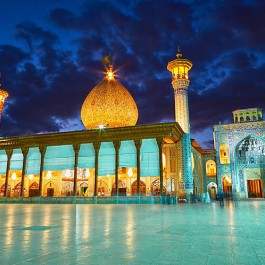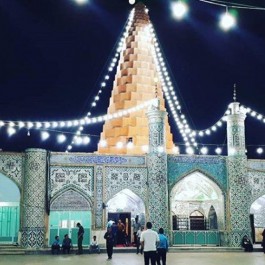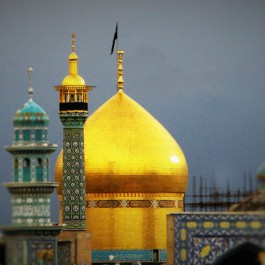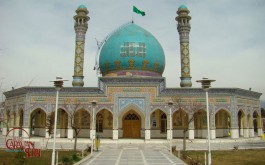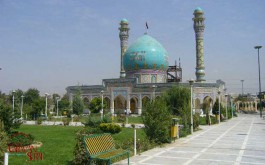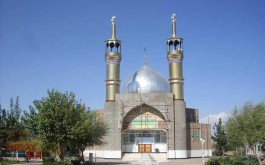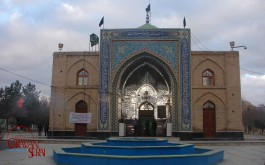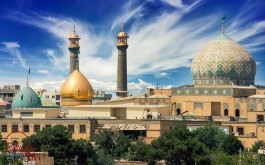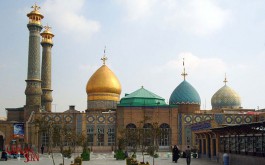Ray is the most traditional city in Iran and a browser in Iran
The ancient land of Rey, dating back to thousands years ago, with the remnants of Iran's Islamic great culture is located at the southernmost part of Tehran. Shahr-e-Rey is an ideal place for pilgrims who are interested in attending tours to explore the ancient history of Iran.
Rey County is one of Tehran province counties in Iran where is limited to Tehran in the north and to Qom in the south, Pakdasht and Varamin in the east and Eslamshahr, Robat Karim, and Zarand in the west. The city is more than 2696 square kilometers in area with a population of 800000.
Shahr-e- Rey is the capital of Rey County, 1062 meters above sea level. The city is situated in the south east of Tehran, in a 14 kilometers distance to the city center of Tehran.
Shahr-e- Rey has a hot and dry climate with the average precipitation of 200 milliliters. Rey County is located in a plain with mountains including Bibi Shahr Banu, Arad Kuh, and Kuh-e Marreh. There are several rivers flowing throughout the county named Karaj River, Jajrud River, Shur River, and Kan River.
In ancient documents, name of Rey is mentioned with different titles. Cases in point, Rega and Rege are among the names which are attributed to this land.
Historic and tourist sites of the city
This ancient city, locating in the south of Iran's capital, has still preserved the symbols of its several thousand years' civilization. In this historical part of Tehran province, you can go on pilgrimage to visit Shah Abdol-Azim shrine; furthermore, the 500 years old Bazaar is another attraction of Shahr-e-Rey. Shah Abbasi Caravansary is situated in the south west of Shah Abdol-Azim square which belongs to the Safavid era. Apart from all these, you can also visit Cheshmeh Ali spring which is an ancient recreational place in Ebn-e Babooyeh neighborhood. Dakhmeh Gabri is another tourist destination that you can enjoy visiting which is a circular building situated in the northern hillside of Mount Bibi Shahr Banu that dates back to Sasanian dynasty. Tabarak and Gabri citadels are the remnants of Rey ancient civilization which are attributed to the era before emergence of Islam in Iran.
Shah Abdol Azim
Shah Abdol Azim was a descendant of Imam Hassan Mojtaba and it has been a long time that citizens of Tehran are interested in visiting his shrine. If you enter Shah Abdol Azim complex from its northern entrance, you will find the building of the shrine in front of you. The initial building of the shrine was constructed during the second half of the third century AH. The main entrance is situated in the north side of the complex which was completed and renovated by the command of Buyid kings. Apart from pilgrimage, you can enjoy observing the inscriptions and brick decorations of the complex.
Imamzadeh Hamzeh
The shrine of Imamzadeh Hamzeh is located in the east part of the Sahn (Sahn is a courtyard in Islamic architecture). Imamzadeh Hamzeh is a descendant of Imam Musa Kazem; additionally, it has been narrated that his shrine is much older than Shah Abdol Azim shrine which was renovated gradually as the time went by. As you reach to this place, you can also visit the tomb of Naser al-Din Shah Qajar.
Imamzadeh Taher
The shrine of Imamzadeh Taher is situated in the southern side of the Sahn where is one of the most beautiful part of the complex with its tiling in the style of Qajar dynasty. It is worth to know that the tomb of the Imamzade, who has
been also known as the descendant of Imam Zayn al-Abidin, had been unknown for centuries that its identity was revealed from the gravestone during renovation of the cemetery. It is narrated that the tomb and Zarih (Zarih is an ornate that encloses a grave in a mosque or Islamic shrine) of Imamzadeh Taher were donated by Zell-e Soltan, the son of Naser al-Din Shah Qajar as his eyes were healed by resorting to the Imamzadeh. If you go on a pilgrimage to visit the shrine of Imamzadeh Taher, you can also visit the tombs of some well-known scholars as Saeid Nafisi and Mehdi Soheili whose tombs are situated in the yard of Imamzade Taher shrine.
Bagh Tooti
There was a garden in the west side of Shah Abdol Azim's shrine that was known as Bagh Tooti where is still remained as an ancient cemetery. If you are interested in history, this cemetery is considered as one of the must-see places in Shahr-e- Rey. Bagh Tooti is one of the most cozy places across the complex where overlooks the whole yard. Many famous people were buried in Shah Abdol Azim complex including Sattar Khan, Muhammad Khiabani, Qaani Shirazi, Ghaem Magham Farahani, Ayatollah Kashani, Muhammad Qazvini, Hosein Ali Mirza Nusret al-Saltaneh, Badiozzaman Forouzanfar, Tayeb Haj Rezae, Muhammad Ali Razm Ara and many other renowned people whose names were repeated for several times in historical documents. A clay gravestone with red colored margins belongs to Sattar Khan who was a prominent figure in the Iranian Constitution Revolution.
Imamzadeh Abdullah
You can easily reach to the shrine of Imamzadeh Abdullah as you walk in Fada'iyan-e Islam Street, within some walking distance to the main square of Shahr-e-Rey. The Imamzadeh is attributed to Imam Zayn-al-Abidin's descendant. The cemetery of Imamzadeh Abdullah with more than 300 tombs is the place where many scholars were buried including Houshang Zaheri, Asadollah Afshar, Emad-ol- Malek Mahdavi, and Mansour Sharif.
Ibn Babawayh
To reach Ibn Babawayh Cemetery, you can take a taxi or bus to Dolat Abad. Ibn Babawayh is considered as the first cemetery of Shahr-e-Rey and the second one in Tehran where Al-Shaykh al-Saduq, also known as Ibn Babawayh, was buried.
